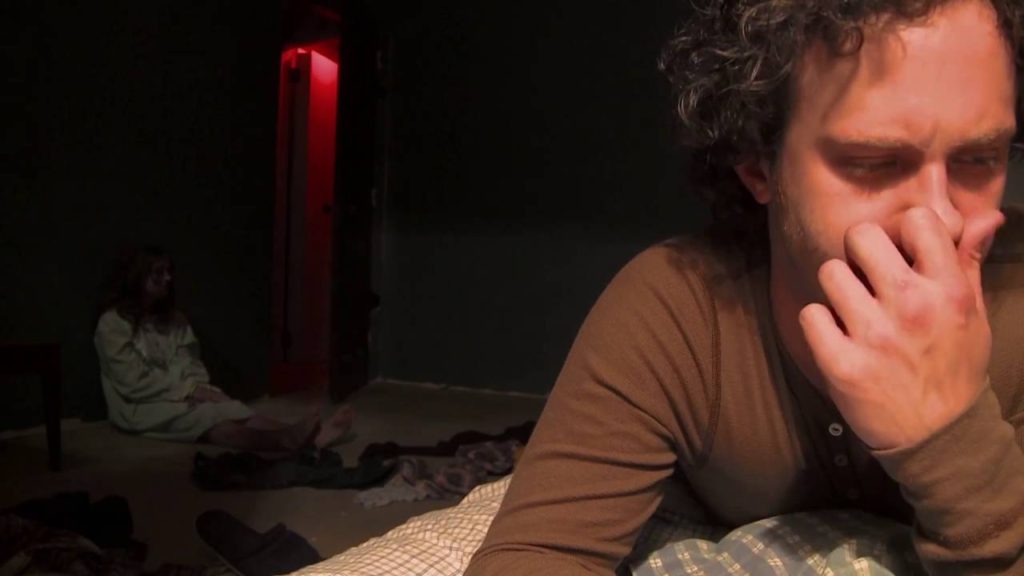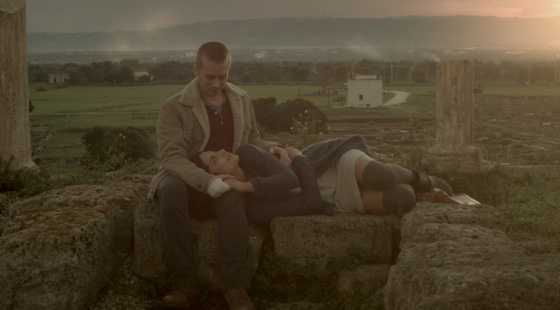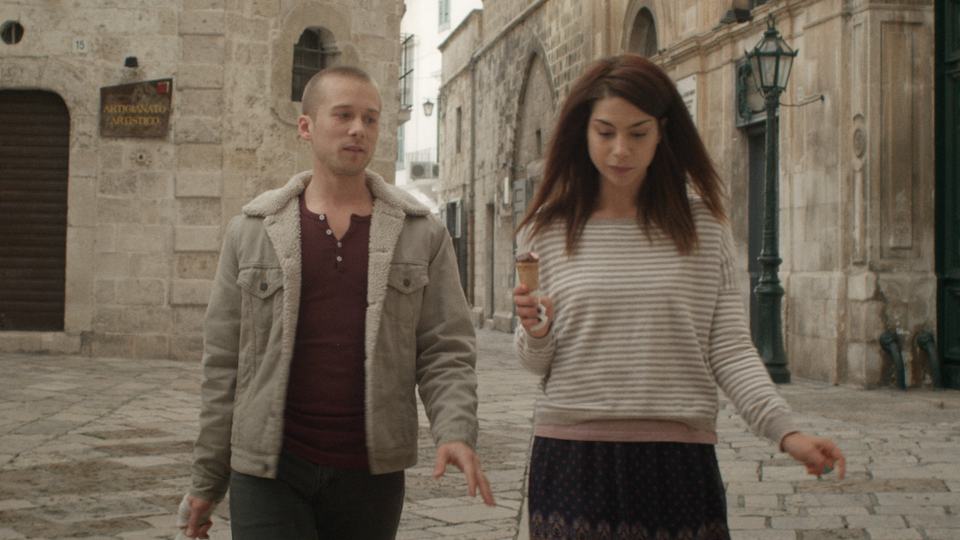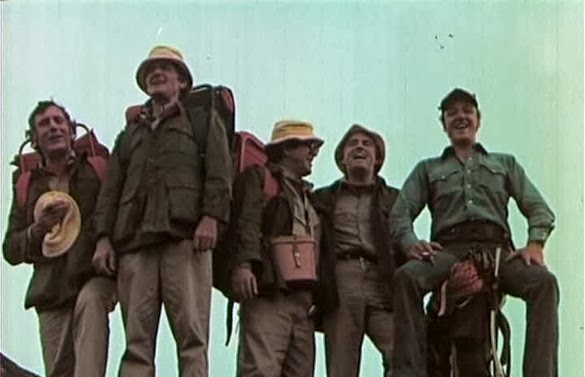
Alternate title: The Gruesome Deaths of the Tilley Hat Brigade.
This January, in support of the Toronto Rape Crisis Centre / Multicultural Women Against Rape, friends and family have raised over $1,000, which means I have to watch and write about thirty-one horror movies. I’ll watch (on average) one movie a night, many of them requested by donors, after which I’ll write some things about said movies on this website. Be forewarned that all such write-ups will contain spoilers! Today’s film is designed to make you scared of the woods: Rituals (a.k.a. The Creeper), directed by Peter Carter (The Rowdyman). The film was not actually suggested by friend and Small Print Toronto organizer Chris Reed, as he – bless his gentle soul – is not a fan of horror films; his suggestions were less than terrifying. (Monsters, Inc.?) But Reed also works for University of Toronto Press, who recently published a very good book of essays on horror movies entitled The Canadian Horror Film: Terror of the Soul. (It’s worth the cover price for Andrea Subissati’s essay on Pontypool alone!) I suggested I could watch a movie featured in the book instead, so it was from The Canadian Horror Film that I learned about the Canadian tax-shelter answer to Deliverance, Rituals. Rituals was rented at Bay Street Video.
What happens:
Who loves camping? Well, if you do, Rituals should cure you of that particular ill, as it – like Deliverance before it – is a film that sets out to demonstrate the soul-crushing terrors that befall city slickers when they decide to go for a hike in the woods. In this case, our city slickers are five doctors, ready to bro out on their annual retreat. Each year, one of the five physicians selects a different location for a wilderness hike. As Rituals opens a seaplane is alighting upon a beautiful lake in Northern Ontario to give the M.D.s the chance for one last restaurant-cooked meal before they head into the great outdoors.
Our doctors – possibly all surgeons – review gruesome photos of operations over a diner lunch. The assembled campers include: the rigidly ethical Harry (Hal Holbrook); his improbably named friend Mitzi (Lawrence Dane); brothers Martin (Robin Gammell) and D.J. (Gary Reineke), who serves as their adult scoutmaster; and Abel (Ken James), a photo enthusiast who I think is supposed to serve as comic relief because he has glasses. (That was kind of comic relief shorthand in 1977.) D.J. is clueing in the other doctors to his newest treatment and business venture: penis enlargement. Harry, the human version of a scowl, grumbles, “is it ethical?” to which D.J. becomes defensive: “What kind of Mickey Mouse question is that?”
The seaplane pilot is shocked at where the five men will be hiking: “That river’s in the middle of the cauldron, and the cauldron’s in the middle of nowhere.” The name of the middle of nowhere is The Cauldron of the Moon, which the local indigenous people believed was where the moon once bumped into the earth, making it an area rife with medicinal properties. The pilot, however, may not be the best judge of anything, given how he nearly knocks the plane into a nosedive in his efforts to show the surgeons his really neat (and long) abdominal scar. The patchwork pilot waves goodbye and the doctors trudge through the untamed wilderness, immediately finding themselves in over their heads. Almost literally. They walk into some swampy water and become entirely drenched. They survive their first day to find the campsite, which doesn’t look anything like the spots they’ve used in Muskoka. They have to clear the abundant brush themselves before setting up their tents.
The first night is filled with all sorts of male-bonding shenanigans. D.J. blows up an inflatable doll. Martin and the shutterbug Abel get riotously drunk. Mitzi and Harry snap at each other like rival crocodiles. When Harry criticizes D.J. for an operation he performed, Mitzi calls Harry a self-righteous bastard. Mitzi continues his attack, suggesting that Harry’s bleeding-heart tendencies leave his patients as “95% plumbing.” They hear a voice howling for Harry in the dark but it turns out to be D.J. playing a trick, sticking his flashlight under his sweater and moaning like a ghost. The whole gang laughs with gusto and jumps into a rousing chant of “Humpty Dumpty” (which is still a pretty common male bonding technique). Though the hike’s been difficult, it’s all good fun until they awake and Martin can’t find his boots. In fact, no one can find their boots. “Why would anyone steal five pairs of boots?” Martin wonders.
D.J. takes decisive action. As the only one who brought a spare pair of shoes, he’s going to head to the nearby hydroelectric dam (twenty-seven miles up river) and find help. Mitzi feels they should instead stay put and signal a helicopter with a fire or something. D.J. pokes a couple holes in that plan: namely that no one ever flies by this area and starting a fire in a forest full of dry wood is a recipe for disaster. D.J. leaves, and he’s not happy about it, noting that he’d never have to walk to the dam on his own if everyone else had followed his Xeroxed instructions and brought extra shoes. (D.J. planned almost all of the trip, so the unpreparedness of his friends really grinds his gears.)
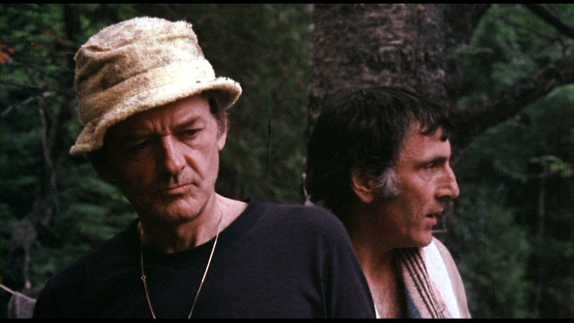
Lead singer from Wheatus and Elliott Gould on a camping trip together.
The four remaining doctors stay at their campsite. When Abel awakes in the middle of the night to urinate, he’s shocked to find a stag’s head mounted on a stick at the edge of their camping area. His screams bring the other doctors running. Mitzi notices a dead snake wrapped around the stick and thinks its similarity to the Rod of Asclepius (symbol of the medical profession) can’t be a coincidence. He blames D.J. for this little scare, but Martin insists his brother would never do anything like this. Harry notices the deer was freshly killed. Mitzi immediately takes inventory of what they have that might be used as a weapon. They have one hatchet.
Spooked by the severed stag’s head, the doctors decide to chase after D.J. and walk toward the dam. Having no shoes, they fashion shoe-like foot bindings out of towels and rope. At a resting spot, Abel has his three friends pose for his camera, but the photo session is interrupted by a fallen (or thrown?) hornet’s nest. They run down a steep hill and into the river to escape the angry hornets. Martin sees a figure moving at the top of the hill as they flee, but can’t be sure if it’s D.J. The unlucky Abel trips on his journey downward and smacks his head against a rock. Unconscious, he drowns in the river. Once the hornets have dissipated, Harry, Mitzi, and Martin realize that Abel has been killed. Martin attempts CPR on the clearly dead Abel and doesn’t stop until some time after Harry repeatedly urges him to stop. Martin then asks if they should say something to mark Martin’s passing. “What? He’s dead,” says Harry, cold as ice.
Martin, who had already been drinking heavily, falls into an alcoholic stupor. Harry himself is a recovering alcoholic who can’t remember most of his time serving in Korea. Late that afternoon, Mitzi finds D.J.’s rope spanning the river. The river is too rough to follow D.J.’s trail, but they’ll wait to see if it’s calmer in the morning. Mitzi goes to start a fire so they can boil some of their freeze-dried meals, but Harry stops him, either afraid of starting an uncontrollable fire or afraid of attracting their stalker. This leaves them with powdered milk, dates, and scotch as sustenance. “There are worse things than powdered milk, I suppose,” Harry says. (Dude, you have no idea.) They attempt to cross the river the next morning, using D.J.’s rope as a guy wire. Unseen by the three doctors, the river is littered with bear traps. Harry plunges his walking stick into one, which snaps and sends the three of them – connected by the rope – deeper into the river. Martin falls right into another trap and screams out in pain.
Amid a chaotic splash-fest, Martin’s friends release him from the bear trap and drag him onto a large rock at the far shore. Harry does some emergency triage on his damaged leg and Martin acts as a backseat surgeon: “Check the artery!” Mitzi becomes increasingly convinced that someone is punishing them for some sort of medical mistake or botched surgery. He asks his friends to confess if they know of any reason someone would want them dead. (Mitzi is the ultimate pragmatist; he admits that if one of them confessed, he would have freely delivered him to their tormenter.) Martin’s leg is messed up real bad, so he won’t be able to continue the hike. So, much to Mitzi’s chagrin, Harry suggests they make a stretcher and float Martin up the river with them. In an excruciating sequence, they set his leg and start to build their raft.
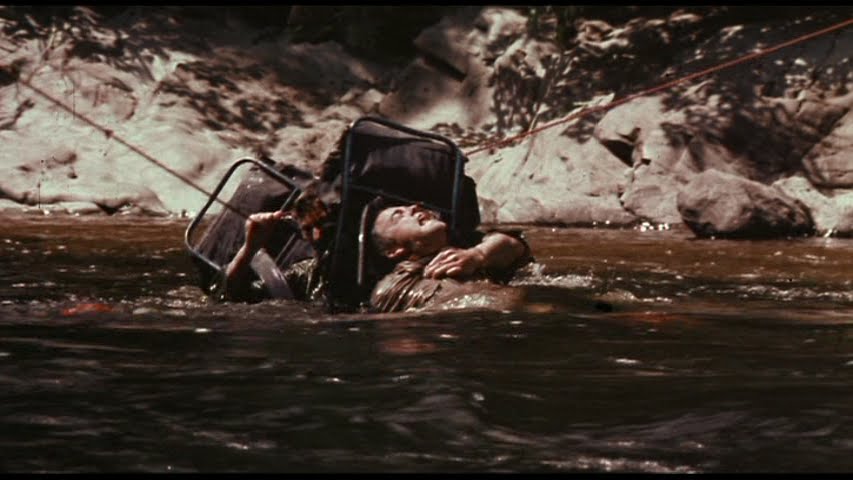
Worst. Log flume. Ever.
Treating Martin like a flotation device, they walk the waterway toward the dam. Martin rambles anecdotes about dogs and armadillos the entire trip. They run into real trouble as the river turns into small waterfalls. Seemingly blocked, Mitzi and Martin take a break by the rocky shore while Harry scouts ahead. Frustrated after drenching his last cigarette, Mitzi starts to turn on Martin (who is, admittedly, becoming very annoying with his nonsense rants). Mitzi calls Martin a “faggot” (Martin is gay, BTW) and attacks him. Harry intervenes and Mitzi starts to trash-talk Harry’s father. The two able-bodied men tussle and their resulting hissy fit leaves Martin at the mercy of the waves. His makeshift boat is sent down the small waterfall where it crashes against some rocks. Harry and Mitzi, coming to their senses, swim to Martin’s rescue.
Martin is alive, but not entirely conscious. He stares blankly, unresponsive to anything but light. (Harry identifies this as a symptom of a subdural hematoma.) Over the course of the night, Harry and Mitzi have a heart-to-heart. Mitzi apologizes for bringing up Harry’s dad, an alcoholic who died alone. Harry, ever the gruff curmudgeon, doesn’t really want to talk about it. In the morning, carrying Martin on his stretcher, the two doctors reach a ridge. They set Martin down and climb the hill, seeing a clear plain ahead: the forest looks like it’s been devastated by a fire. When they return to Martin, a service medal from World War II has been pined to his shirt.
Mitzi and Harry continue to carry Martin on what seems a futile journey to the dam. Mitzi begins to worry they’re going completely the wrong way – having emerged from the woods, shouldn’t they be able to see the dam in the distance now? They carry the wounded Martin along a very steep, rocky slope (which seemed really precarious), at one point slipping and nearly falling of the sharp drop to their side. Running out of patience and options, they argue over some hard decisions. Mitzi really wants to ditch Martin, a friend who is rapidly becoming a really heavy albatross around their necks. Harry, who has slowly visually transformed into Rambo (though several years before that movie’s release), won’t hear it. Mitzi is incredulous. After all, Harry abandoned his father, why not this dude? Figuring things will seem better after a good night’s sleep (I’m doubtful), they take shifts keeping watch and settle down to rest atop the rocky cliff.
Mitzi, having fallen asleep during his shift, opens his eyes to find their long-forgotten friend Abel – or his head, at least – spiked upon a branch. Harry, awakened by his screams, sees the head and tosses the Abel-kebab off the cliff. Clearly, he’s upset that Mitzi dozed during his watch, but he’s also intrigued by something else the killer left: an X-ray from an army medical facility in the 1940s. The X-ray shows a human skull that was the unlucky recipient of some shoddy facial surgery. The mystery deepens! Harry, disgusted (from a professional standpoint, I assume), notes, “at least we have some idea of what we’re dealing with.” (I don’t!) Mitzi wants to get out of Dodge as fast as possible, and that scenario doesn’t involve dragging around the near-catatonic Martin. Harry, however, picks up one end of the stretcher and starts dragging Martin. Mitzi refuses to help. “He’s a vegetable,” Mitzi shouts. “You’ll get yourself killed.” Harry stubbornly and single-handedly drags the stretcher down the rocky hill.
But lest we think that Harry is some kind of stone-faced Superman, he soon collapses in the heat of the sun and the stretcher pins his leg to the ground. Harry begins to curse and rave, almost speaking in tongues. (Really, it’s closer to a Yosemite Sam impression.) A shadow falls over him and when he looks to the sky, the sun has been blotted out by his friend Mitzi, who reluctantly helps him carry the stretcher. A little while later, the two doctors begin to hear the roar of rushing water. The dam must be close ahead! But when they see the hydroelectric dam, their hope completely evaporates. Mitzi breaks down crying when he sees it: the dam is in ruins. It clearly hasn’t been maintained for years.
The hydroelectric dam isn’t entirely unpopulated, though. There is one resident: D.J. Their old friend is found tied to a chair with a pipe driven through his thigh. In disgust, Harry pulls another two documents that have been pinned to the pipe: another X-ray and a medical discharge note for one “Matthew Crowley.” Harry starts to untie D.J.’s dead body – I’m not exactly sure why – and D.J. stirs. Could he still be alive in the ravaged state he’s in? Harry stands behind his old friend and chokes the life from him as a mercy kill. Doctor-assisted suicide at its rawest. (Sorry.)
Tragically, Harry skipped class the week they were studying X-ray comprehension.
By the time Harry has finished getting his kill on, Mitzi has fled. Harry can find no sign of him. Harry, his crucifix now overly evident, begins to cry. He informs the unresponsive body of Martin that he can’t carry him any further, but promises he’ll return for him later. But as Harry pets his friend’s hand, he realizes Martin has already died. He places the crucifix in Martin’s hand and leaves the dam behind.
By night, Harry eventually stumbles across a cabin. The cabin is empty, so he enters, helps himself to some food, Goldilocks-style, and goes through a the owner’s scrap book. He finds a medal inside then turns around to see five pairs of boots under the bed. That’s when Harry realizes exactly whose cabin he’s in. (Who else‘s cabin did you think it would be, Harry? And you graduated from medical school?) A bearded old man enters and begins to swing at Harry with a shovel, but Harry hits him with a hatchet. This knocks the man flat on his back, but before he delivers the death stroke, Harry realizes the old man is blind.
The man asks if Harry is “one of them doctors,” apologizing about his brother. He says he tried to stop him. Jesse (Jack Creley) is Matthew’s brother, and has been living with the killer in the woods for years. Harry, understanding this man is not (directly) responsible for his friends’ murders, helps him into bed. Jesse warns him he should run, as the cabin is not safe. But Harry whispers, “I don’t know where to go.” Unfortunately, big brother shows up not soon after. Harry goes for the household shotgun. Matthew, unseen, stabs through the window and slices Harry’s thigh. Harry desperately aims the gun into the darkness outside, but has immense trouble loading it. One of the shotgun shells jams in the barrel, so a jittery Harry has to remove it with a butter knife. But Matthew has seemingly disappeared by the time he loads and cocks the gun. That’s when Harry hears someone yelling outside.
That someone is Mitzi, currently tied up and hanging from a tree. He yells for Harry’s help, saying that Matthew is somewhere below him. Harry shouts out to warn Matthew that he has a gun, but this doesn’t seem to faze Matthew – still not seen – who starts a fire under Mitzi’s dangling body. Harry tells Mitzi that his artery has been cut (in his thigh … it’s pretty nasty), and that Matthew’s brother is in the cabin with him. Mitzi pleads for his friend to trade Jesse for him. But old doctor habits die hard and Harry feels it’s really important to cauterize that thigh wound first. So, using gunpowder and a lantern, he does the job, and it hurts quite a lot (as you might imagine). As Harry rolls on the floor in agony, Mitzi succumbs to the fire outside. When Harry gets to his feet he witnesses Mitzi engulfed in flames.
Matthew tosses a firebrand into the cabin, then reaches his arm in the window, attempting to unlock the front door. Harry aims and blows Matthew’s hand off at the wrist. When Matthew enters, finally visible for the first time in the film, he holds his bleeding stump aloft. Half his face has been burned and mangled (in some surgery gone wrong, I guess). Matthew reaches out to Harry with his dog tags and Harry shoots him dead with the shotgun. In the movie’s final scene, Harry – now looking more Moses than Rambo – with makeshift robes and walking stick, finally reaches a highway. He steps into the middle of the road, sits down and waits, dog tags in hand.
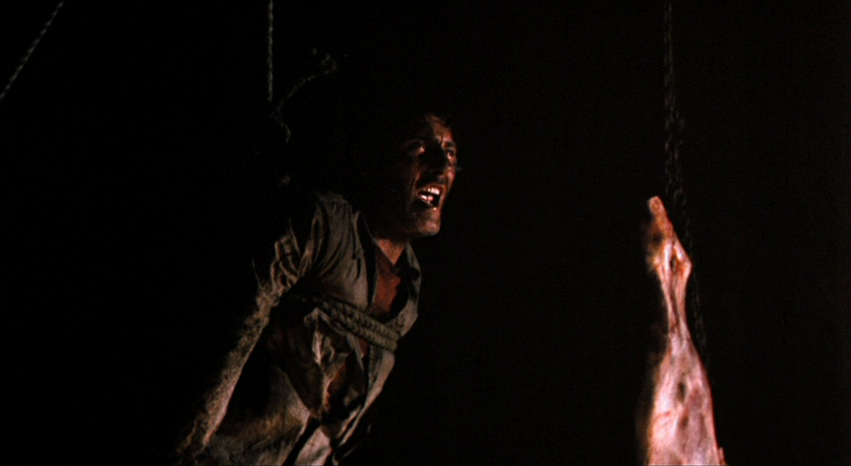
Turns out it’s just a simple misunderstanding about comedy roasts.
Takeaway points:
- What makes Rituals different from other slasher films? All the doctors, for one. The movie makes it feel like the Hippocratic Oath is on trial. These are men who have dedicated their life to do no harm, but if we consider the case of Matthew, the mostly unseen killer, at least one doctor (in history) has done some harm. And the notion of a bad surgery ruining (or ending) one’s life runs through outRituals. Harry butts heads with the other doctors over what he feels are unethical practices. He maintains his righteousness to extreme ends, even when it threatens his survival. Surely, abandoning Martin earlier would have positively impacted his survival odds, and the far more pragmatic Mitzi realizes that. Mitzi is every-man-for-himself; their opposition is established from the opening conversation about Lakeview Hospital. Rituals takes the righteous Harry and pushes him to his limits to see what he’s willing to sacrifice for those ethics. What’s jarring is Mitzi, the pragmatist, bargaining for his life at the end, while Harry – for once – decides to put his own health first. “Physician, heal thyself,” has never seemed such a grim quotation.
- Another thing that makes Rituals different from other slasher films: it’s a bunch of middle-aged dudes. Gone are the fresh-faced teenagers (or occasionally, college-aged students) seen in most slasher films. The producers know what the kids really want to see: craggy-faced men going camping! I joke, but it’s kind of nice to see against-type slasher victims. It reminds me of Liam Neeson film, The Grey: at once a gory horror film and a sombre meditation on survival, friendship, and personal ethics.
- The Canadian landscape – particularly the harsh landscape of northern Ontario – is the co-star in Rituals. The environment looks just as dangerous as the mysterious stalker. It’s funny to think that this same landscape that inspired many paintings from seminal Canadian artists The Group of Seven should serve such a menacing purpose here. You can even see Tom Thomson trees! (Settle down; I know he wasn’t a member of the Group of Seven.) Truthfully, it looks like the environment – blackflies and all – was really unpleasant place to film.
- If nothing else, Rituals seems to be telling us – like Lost was to tell us decades later – doctors have drinking problems and daddy issues. And those two things are inextricably linked. Interestingly, it’s the one man on the journey who abandoned both the drink and his father who survives the ordeal.
- A good forty minutes into the film, Martin assesses his life: “I’m thirty-eight years old, an independent alcoholic, and my last boyfriend was a borderline psychopath.” What’s notable is that this movie was released in 1977, and this is one of only two references to Martin’s homosexuality. If Rituals were released today, I would think nothing of a gay man and his four straight friends going on a wilderness trek together. But forty years ago, it was rare for gay characters to appear in cinema – and rarer still for ones who were not over-the-top caricatures to do so. The revelation (to the audience; his friends already know) that Martin is gay is handled the same way as if we learned he was Episcopalian. It’s entirely commendable, if not kind of incredible. (Of course, Mitzi ruins it later by dropping a gay slur, but the utopia was nice while it lasted … y’know, aside from all the murder.)
Truly terrifying or truly terrible?: Rituals is not so much a movie you’re frightened by as it is a movie you endure or survive. That’s fitting, as it’s survivalist horror. While it’s harrowing and takes us to the edge of humanity where friendship and ethics are shattered in the preservation of base survival, it’s more akin to something like The Revenant or 127 Hours. It might make you rethink your next camping trip, but I’m not sure it will give you any sleepless nights.

Harry (Hal Holbrook), rocking the military chic look.
Best outfit: D.J.’s Montreal Expos cap is the star of the show, but Harry is the real fashion plate. From a rumpled bucket hat to a military vest over a tight black T-shirt, is there anything Harry can’t pull off?
Best line: “Self-sacrifice is all right, as long as you can pay the bills.” – Martin, quoting the feelings-free Harry
Best kill: Matthew’s death isn’t exciting, but the way Harry shoots off his hand certainly is. And, cathartically speaking, it was just such a relief when Matthew takes a dirt nap.
Unexpected cameo: You probably recognize star Hal Holbrook from his role in Into the Wild, or maybe as Deep Throat from All The President’s Men. But did you recognize the diner hostess – the sole woman in the movie – as the film’s male director, Jack Carter?
Unexpected lesson(s) learned: I once went dogsledding in the Northwest Territories. (It sounds more adventurous than it was.) My dogsledding partner was a surgeon at the Yellowknife hospital. I thought to myself, what great luck to be travelling with a doctor. If we crash or if any sort of crisis happens, I have a doctor right here. But Rituals makes me reconsider how handy it would be to have doctors on hand in an emergency situation.
Most suitable band name derived from the movie: The Juice Artists
Next up: Flesh Eating Mothers (1988).

